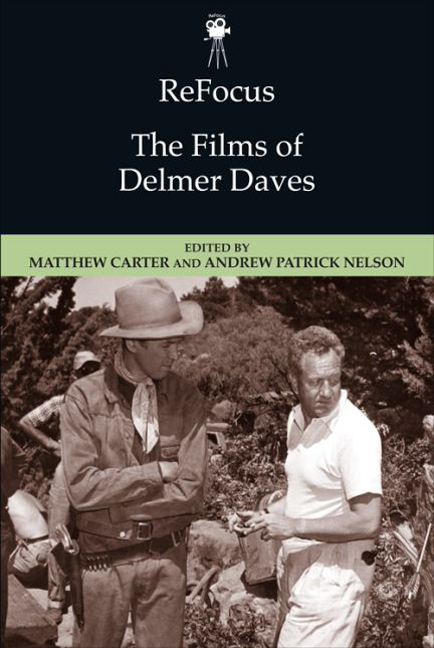Book contents
- Frontmatter
- Contents
- List of Figures
- Notes on Contributors
- Acknowledgments
- Introduction: “No One Would Know It Was Mine”: Delmer Daves, Modest Auteur
- 1 Don't Be Too Quick to Dismiss Them: Authorship and the Westerns of Delmer Daves
- 2 Trying to Ameliorate the System from Within: Delmer Daves’ Westerns from the 1950s
- 3 Bent, or Lifted Out by Its Roots: Daves' Broken Arrow and Drum Beat as Narratives of Conditional Sympathy
- 4 This Room is My Castle of Quiet: The Collaborations of Delmer Daves and Glenn Ford
- 5 Delmer Daves, Authenticity, and Auteur Elements: Celebrating the Ordinary in Cowboy
- 6 Home and the Range: Spencer's Mountain as Revisionist Family Melodrama
- 7 Delmer Daves’ 3:10 to Yuma: Aesthetics, Reception, and Cultural Significance
- 8 Changing Societies: The Red House, The Hanging Tree, Spencer's Mountain, and Post-war America
- 9 Partial Rehabilitation: Task Force and the Case of Billy Mitchell
- 10 “This Is Where He Brought Me: 10,000 Acres of Nothing!”: The Femme Fatale and other Film Noir Tropes in Delmer Daves’ Jubal
- Index
4 - This Room is My Castle of Quiet: The Collaborations of Delmer Daves and Glenn Ford
Published online by Cambridge University Press: 15 September 2017
- Frontmatter
- Contents
- List of Figures
- Notes on Contributors
- Acknowledgments
- Introduction: “No One Would Know It Was Mine”: Delmer Daves, Modest Auteur
- 1 Don't Be Too Quick to Dismiss Them: Authorship and the Westerns of Delmer Daves
- 2 Trying to Ameliorate the System from Within: Delmer Daves’ Westerns from the 1950s
- 3 Bent, or Lifted Out by Its Roots: Daves' Broken Arrow and Drum Beat as Narratives of Conditional Sympathy
- 4 This Room is My Castle of Quiet: The Collaborations of Delmer Daves and Glenn Ford
- 5 Delmer Daves, Authenticity, and Auteur Elements: Celebrating the Ordinary in Cowboy
- 6 Home and the Range: Spencer's Mountain as Revisionist Family Melodrama
- 7 Delmer Daves’ 3:10 to Yuma: Aesthetics, Reception, and Cultural Significance
- 8 Changing Societies: The Red House, The Hanging Tree, Spencer's Mountain, and Post-war America
- 9 Partial Rehabilitation: Task Force and the Case of Billy Mitchell
- 10 “This Is Where He Brought Me: 10,000 Acres of Nothing!”: The Femme Fatale and other Film Noir Tropes in Delmer Daves’ Jubal
- Index
Summary
The theatrical trailer for Delmer Daves’ episodic 1958 Western, Cowboy, opens in black and white and features a solitary, seated figure impatiently clicking through the channels of a television, all of which show the same generic Western situation of a posse riding through a rocky, dusty, and ill-defined landscape: “Pardner, I don't mind sayin’ I'm plum sick of childish Westerns.” The trailer then cuts to the figure of Jack Lemmon, in cowboy attire, introducing the film he co-stars in: “it's really the West.” Such a playful approach to the advertising of a Hollywood film is not that unusual by the late 1950s, but this trailer also pushes some of the key ways in which we are meant to receive and respond to the film in question, as well as its adversarial relationship to television.
Cowboy was made on the cusp of the great boom in the television Western that reached its peak in the early 1960s, a shift of medium and scale that highlighted the mundane, domestic, serialized, largely historically comfortable and generic characteristics of the form that were soon to be busted apart, or hyperbolically restaged, in the revisionist Westerns of directors such as Sergio Leone, Sam Peckinpah, and Robert Altman. Although Daves’ film is not a revisionist Western in this sense—its aim is more circumspect, less aggressive, and clearly attentive to the existing legacies and histories of the West—it is plainly being promoted as something of an antidote to the redundancies of the serialized Western and the form of television itself. This trailer also highlights Cowboy's “adult,” realistic, naturalistic, “diurnal,” and large-scale interventionist ambitions in relation to the genre. Although it aims to highlight the workaday actualities of cowboy life, its approach and setting are distinct from the sanitized backlots, domesticity, interiorized and clapboard main-street dramas of the TV Western.
In this trailer Cowboy is not promoted in terms of its director—Daves was a respected figure by this stage, but hardly a household name—and it doesn't make too much of the presence of Glenn Ford in a starring role, either, although he was then one of the biggest box-office attractions in the world.
- Type
- Chapter
- Information
- ReFocus: The Films of Delmer Daves , pp. 102 - 117Publisher: Edinburgh University PressPrint publication year: 2016



